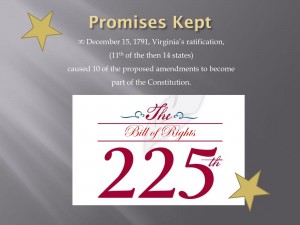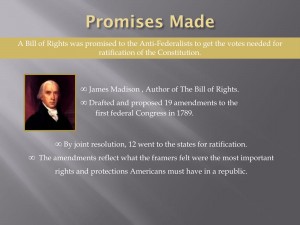 December 15, 2016 was the 225th anniversary of one of the great achievements in the history of mankind: affirmation of the inalienable rights of man and specific limits on the power of government to interfere with the rights we are all born with under the laws of nature and nature’s God. These rights were affirmed with the ratification of the first ten amendments to the US Constitution: The Bill of Rights.
December 15, 2016 was the 225th anniversary of one of the great achievements in the history of mankind: affirmation of the inalienable rights of man and specific limits on the power of government to interfere with the rights we are all born with under the laws of nature and nature’s God. These rights were affirmed with the ratification of the first ten amendments to the US Constitution: The Bill of Rights.
How did the Bill of Rights come to be?
On July 4, 1776, The Declaration of Independence stated the truth that we possess the inalienable rights of life, liberty and the pursuit of happiness. The Declaration did more by detailing how the King of England interfered with those rights, and the list of abuse of those rights by the king would come to inspire many of the protections found in the Bill of Rights.
On September 17. 1787, The Constitution would propose a grant of power to the central government by the People of the United States based upon principles found both in the Declaration of Independence and the Preamble.
On December 15, 1797; the Bill of Rights became the final piece to Founding of the United States by placing important limits on the Constitution’s grant of power. These limits not only recognized the natural rights given to human beings by their Creator but also defined how the government was to conduct itself to limit abuses like those suffered at the hands of the king of England.
Ratification of Proposed Constitution Not Assured
The Constitutional Convention finished its work on September 17, 1787. The Constitution’s Article VII provided that the Constitution would go into effect when nine of the thirteen states had ratified the document. Ratification was by no means assured. There were groups known as Federalists that favored ratification and the Anti-Federalists who opposed the Constitution.
Among the arguments made against the Constitution by the Anti-Federalists was the lack of specific protections from the federal government for citizens of their most important natural rights. The proposed Constitution did not have protections from a strong government engaging in abuses colonists had suffered under the British. To secure votes for ratification, in a number of states, but in Massachusetts in particular, proponents of the Constitution promised to amend the document to address the lack of the Bill of Rights once the document went into effect.
James Madison would propose the Bill of Rights
 The promise was kept after the Constitution’s ratification and after the Federalists won significant majorities in both the House and Senate in the nation’s first congressional elections. This is a testament to the political honor and commitment to keeping a promise that existed among American leaders of the 18th century. An example for 21st century politicians exists in the story of the Bill of Rights.
The promise was kept after the Constitution’s ratification and after the Federalists won significant majorities in both the House and Senate in the nation’s first congressional elections. This is a testament to the political honor and commitment to keeping a promise that existed among American leaders of the 18th century. An example for 21st century politicians exists in the story of the Bill of Rights.
James Madison proposed 19 amendments to the First United States Congress. Congress, by joint resolution, sent 12 of these amendments to the states on September 25, 1789. On December 15, 1791, with Virginia’s ratification, (11th of the then 14 states) 10 of the proposed amendments became part of the Constitution through the Constitution’s Article V amendment process.
Promises Made, Promises Kept
The addition of the Bill of Rights not only kept the promise of the Federalist advocates of ratification. It was a confirmation of the outlined in the Declaration of Independence. This act of the new government, consistent with its founding philosophy, further solidified the support of the population for the new government and its legal legitimacy.
The Execution of the Philosophy, Not Just a Statement, but Procedures.
 How many rights are in the Bill of Rights?
How many rights are in the Bill of Rights?
1st: 5
2nd: 1
3rd: 1
4th: 2
5th: 5
6th: 6
7th: 1
8th: 3
The Ninth and Tenth don’t define specific rights as the other amendments do, but rather announce that not all rights that men possess are enumerated in the Bill of Rights and define a reservation of power.
Two-Thirds of the Rights are Found in Four Amendments
There are 24 rights found in Amendments 1 through 8, with 16 of these in Amendments 4, 5, 6 and 8. So 2/3 of the rights in the Bill of Rights are found in these four amendments. While numbers alone do not denote importance, there’s surely something important going on here. The Fourth, Fifth, Sixth and Eighth are different from the expression of unalienable rights in the First and Second, the Third’s common sense of keeping soldiers out of your house, and the Seventh’s jury trial guarantee in Federal civil trials.
These four amendments are all procedures for protecting the rights of life, liberty and the pursuit of happiness found in the Declaration of Independence from government. The greatest threat that government poses to a citizen’s three great rights is the power to take those away through the accusation, prosecution and conviction of a crime. These four amendments deal with “procedural” rights for the protection against the arbitrary and vindictive exercise of government power when it endeavors to punish a citizen by taking away his life, liberty or property.
Limitations on government in the use of its powers to take away life liberty and property was foremost in the minds of the Founders. The British had misused criminal prosecutions for political purposes. The 4th, 5th, 6th and 8th Amendments grew out of that experience and established procedures to limit government’s ability to interfere with and protect the great rights found in the other amendments.
Given the great power of government to exercise control over the life, liberty and property of its citizens through the criminal law, it was critical not just to place restrictions on government interference with the great Natural Rights found in Amendments 1 and 2, but to put in place, constitutional limitations on government when it exercised its authority in the criminal arena. 2/3 of the Bill of Rights is devoted to making certain when government exercises its most invasive power, it does so in a way to ensure the due process of law.
The procedures established in the 4th, 5th, 6th and 8th Amendments are there to protect life, liberty and the pursuit of happiness when the government seeks to take those very rights away.
An overview of these four amendments are found in Part II.






[…] traditions of freedom, self-defense, religious liberty and the gifts America was given by its Founders. Yet in extolling America’s blessings he advises the countries of the world to look to their own […]